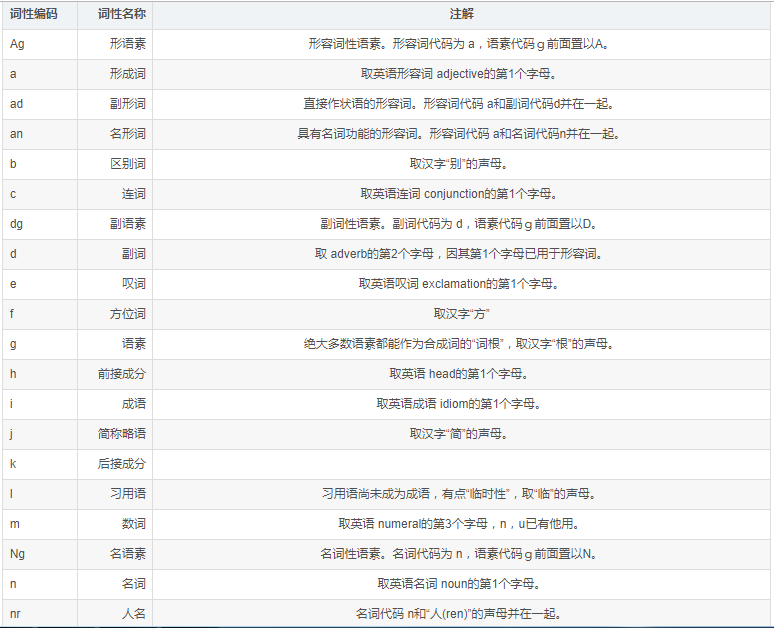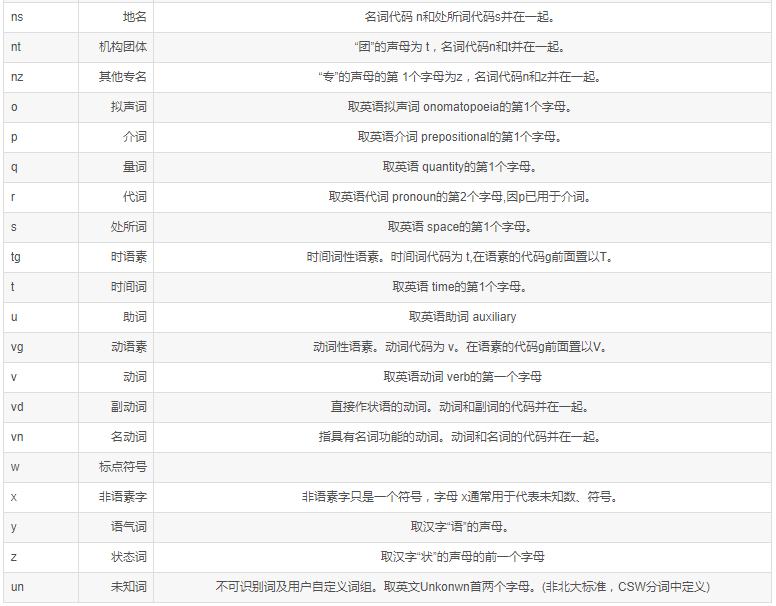jieba、NLTK学习笔记
中文分词 - jiebaimport re
import jieba
news_CN = '''
央视315晚会曝光湖北省知名的神丹牌、莲田牌“土鸡蛋”实为普通鸡蛋冒充,同时在商标上玩猫腻,
分别注册“鲜土”、注册“好土”商标,让消费者误以为是“土鸡蛋”。3月15日晚间,新京报记者就此
事致电湖北神丹健康食品有限公司方面,其工作人员表示不知情,需要了解清楚情况,截至发稿暂未
取得最新回应。新京报记者还查询发现,湖北神丹健康食品有限公司为农业产业化国家重点龙头企
业、高新技术企业,此前曾因涉嫌虚假宣传“中国最大的蛋品企业”而被罚6万元。
'''
# 字符串清洗
string = re.sub('[^\w]', '', news_CN) #使用正则去符号,之后都是用这个str字符串
# 分词
seg_list = jieba.cut(string, cut_all=False, HMM=False) #精确模式(默认)| 全模式
#seg_list = jieba.cut_for_search(string, HMM=False) #搜索引擎模式,粒度较细
#jieba.lcut(), jieba.lcut_for_search() #直接返回list,不加返回生成器
print('/'.join(seg_list))
# 返回词语在原文中出现位置
seg_list = jieba.tokenize(u'自然语言处理非常有用') #[('自然语言', 0, 4), ...]
# 词性标注
import jieba.posseg as psg
seg_list = psg.cut(news_CN)
'''psg.POSTokenizer(tokenizer=None)
#tokenizer参数可使用 jieba.Tokenizer(dictionary=DEFUALT_DICT) #新建自定义分词器,可用于同时使用不同字典
#jieba.posseg.dt为默认词性标注分词器
'''
print(' '.join(['{0}/{1}'.format(w, t) for w, t in seg_list]))
'''
path = ''
file=open(path,'r')
jieba.load_userdict(file)
file.close()
'''
# 加载自定义词
'''
userdict.txt
一个词占一行
每一行分三部分:词语、词频(可省略)、词性(可省略)
用空格隔开,顺序不可颠倒
file_name
若为路径或二进制方式打开的文件,则文件必须为UTF-8编码
'''
# 结巴默认词库位置: {basepath}\Lib\site-packages\jieba\dict.txt
#如果不知道新加词汇的词频词性的话,可写成:词 3 n
jieba.set_dictionary('./data/dict.txt.big') #加载系统词典
jieba.load_userdict(['神丹牌','莲花牌','土鸡蛋','新京报']) #载入词典, filename='userdict.txt'
jieba.add_word('自定义词', freq=None, tag=None) #动态修改词典
jieba.del_word('自定义词')
jieba.get_FREQ('神丹牌')
jieba.suggest_freq(('龙头企业','高新技术企业'), True) #调节单个词语的词频,使其能(或不能)被分出来
seg_list = jieba.cut(string, cut_all=False) #精确模式 str 为之前的字符串
print('/'.join(seg_list)) #词典中指定的词不会拆分
# 基于TF-IDF算法的关键词抽取
import jieba.analyse as aly
#aly.TFIDF(idf_path=None)
aly.set_idf_path('./data/idf.txt.big') #加载自定义idf词典
aly.set_stop_words('./data/stop_words.utf8') #加载停用词典
keywords = aly.extract_tags(news_CN, topK=10, withWeight=True, allowPOS=()) #allowPOS为保留词性,为空不过滤
keywords = aly.textrank(news_CN, topK=10, withWeight=True, allowPOS=('ns', 'n', 'vn', 'v')) #为空过滤所有
from sklearn.feature_extraction.text import CountVectorizer, TfidfTransformer
corpus = [
'This is the first document.',
'This is the second document.',
'And the third one.'
]
#words = CountVectorizer().fit_transform(corpus)
#tfidf = TfidfTransformer().fit_transform(words) #稀疏矩阵
tfidf = TfidfTransformer().fit_transform(corpus) #结果一样
print(tfidf)
# 并行分词
# 按行多进程并行,基于 python 自带的 multiprocessing 模块,目前暂不支持 Windows
jieba.enable_parallel(4)
jieba.disable_parallel()
英文分词 - NLTK
import nltk
# ------------------------------------
#先分句再分词
text = "And now for something completely different. I love you."
sentences = nltk.sent_tokenize(text)
words = []
for sent in sentences:
words.append(nltk.word_tokenize(sent))
#words_tagged += nltk.pos_tag(nltk.word_tokenize(sent))
# ------------------------------------
#分词
words = nltk.word_tokenize("good good study, day day up!")
# ------------------------------------
#词性标注
tagged = nltk.pos_tag(words)
print (tagged[0:6])
for word in tagged:
if 'NNP' == word[1]: #首字母大写都判为专有名词了
print(word)
#命名实体识别
entities = nltk.chunk.ne_chunk(tagged) #树
print (entities)
# ------------------------------------
#词频统计
words = nltk.word_tokenize("good good study, day day up!")
fdist = nltk.FreqDist(words)
fdist.N() #总词数
fdist.B() #词典大小
fdist['good'] #频数
fdist.freq('good') * 100 #频率
fdist.tabulate(5, cumulative=False) #前5个词的频数分布
fdist.plot(5, cumulative=True) #前5个词的累计频数分布图
#词组统计
bgrams = nltk.bigrams(words)
bgfdist = nltk.FreqDist(list(bgrams))
bgfdist.plot(10) #前十词组
基于TF-IDF算法的关键词提取
- jieba.analyse.extract_tags(sentence, topK=20, withWeight=False, allowPOS=())
其中需要说明的是:
1.sentence 为待提取的文本
2.topK 为返回几个 TF/IDF 权重最大的关键词,默认值为 20
3.withWeight 为是否一并返回关键词权重值,默认值为 False
4.allowPOS 仅包括指定词性的词,默认值为空,即不筛选
- jieba.analyse.TFIDF(idf_path=None) 新建 TFIDF 实例,idf_path 为 IDF 频率文件
#设置逆文档频率语料库
#jieba.analyse.set_idf_path(file_name)
#劳动防护 13.900677652 勞動防護 13.900677652 ...
#设置停用词语料库
#jieba.analyse.set_stop_words(file_name)
import jieba
import jieba.analyse
#读取文件,返回一个字符串,使用utf-8编码方式读取,该文档位于此python同以及目录下
content = open(u'人民的名义.txt','r',encoding='utf-8').read()
jieba.analyse.set_stop_words("stopwords.txt")
tags = jieba.analyse.extract_tags(content, topK=10,withWeight=True)
for tag in tags:
print("tag:%s\t\t weight:%f"%(tag[0],tag[1]))


英文分词 - NLTK - 词形还原、词性还原、词干提取
转自:NLTK英文分词尝试
NLP Lemmatisation(词性还原) 和 Stemming(词干提取) NLTK pos_tag word_tokenize
Python nltk.WordNetLemmatizer() Examples
import re, time, collections, nltk
from sklearn.datasets import fetch_20newsgroups
from nltk.stem.wordnet import WordNetLemmatizer
from nltk.tokenize import word_tokenize
from nltk.corpus import stopwords
# -----------------------------------
''' 词形还原 '''
# 正则表达式过滤特殊符号用空格符占位,双引号、单引号、句点、逗号
pat_letter = re.compile(r'[^a-zA-Z \']+')
# 还原常见缩写单词
pat_is = re.compile("(it|he|she|that|this|there|here)(\'s)", re.I)
pat_s = re.compile("(?<=[a-zA-Z])\'s") # 找出字母后面的字母
pat_s2 = re.compile("(?<=s)\'s?")
pat_not = re.compile("(?<=[a-zA-Z])n\'t") # not的缩写
pat_would = re.compile("(?<=[a-zA-Z])\'d") # would的缩写
pat_will = re.compile("(?<=[a-zA-Z])\'ll") # will的缩写
pat_am = re.compile("(?<=[I|i])\'m") # am的缩写
pat_are = re.compile("(?<=[a-zA-Z])\'re") # are的缩写
pat_have = re.compile("(?<=[a-zA-Z])\'ve") # have的缩写
def replace_abbreviations(text):
new_text = text
new_text = pat_letter.sub(' ', text).strip().lower()
new_text = pat_is.sub(r"\1 is", new_text)
new_text = pat_s.sub("", new_text)
new_text = pat_s2.sub("", new_text)
new_text = pat_not.sub(" not", new_text)
new_text = pat_would.sub(" would", new_text)
new_text = pat_will.sub(" will", new_text)
new_text = pat_am.sub(" am", new_text)
new_text = pat_are.sub(" are", new_text)
new_text = pat_have.sub(" have", new_text)
new_text = new_text.replace('\'', ' ')
return new_text
# -----------------------------------
''' 词干提取 '''
# 基于Porter词干提取算法
from nltk.stem.porter import PorterStemmer
porter_stemmer = PorterStemmer()
porter_stemmer.stem('leaves') #输出:leav,实际:leaf
porter_stemmer.stem('maximum')
# 基于Lancaster 词干提取算法
from nltk.stem.lancaster import LancasterStemmer
lancaster_stemmer = LancasterStemmer()
lancaster_stemmer.stem('maximum')
# 基于Snowball 词干提取算法
from nltk.stem import SnowballStemmer
snowball_stemmer = SnowballStemmer('english')
snowball_stemmer.stem('maximum')
# -----------------------------------
''' 词性还原 '''
def lemmatize_all(sentence, stopWords):
# lemmatize()方法将word单词还原成pos词性的形式
wnl = WordNetLemmatizer()
for word, tag in nltk.pos_tag(word_tokenize(sentence)):
if word in stopWords:
continue
elif tag.startswith('NN'):
#pos = nltk.corpus.wordnet.NOUN
yield wnl.lemmatize(word, pos='n')
elif tag.startswith('VB'):
#pos = nltk.corpus.wordnet.VERB
yield wnl.lemmatize(word, pos='v')
elif tag.startswith('JJ'):
#pos = nltk.corpus.wordnet.ADJ
yield wnl.lemmatize(word, pos='a')
elif tag.startswith('R'):
#pos = nltk.corpus.wordnet.ADV
yield wnl.lemmatize(word, pos='r')
else:
#按词性剔除
continue
#yield word
#查看词性说明
nltk.help.upenn_tagset('JJ')
# -----------------------------------
''' 词频统计 '''
def word_frequency_count(contents, stopWords):
word_count_dict = collections.defaultdict(lambda:0)
for text in contents:
new_text = replace_abbreviations(text)
words = lemmatize_all(new_text, stopWords)
word_dict = collections.Counter(words)
for key in word_dict:
word_count_dict[key] += word_dict[key]
return word_count_dict
if __name__=='__main__':
t0 = time.time()
news = fetch_20newsgroups(subset='all')
stopWords = set(stopwords.words('english')) | set(['the','a'])
word_count_dict = word_frequency_count(news.data[:30], stopWords)
#print('高频词:', word_count_dict.most_common())
word_items = list(word_count_dict.items())
word_items.sort(key=lambda x:-x[1])
print('高频词:', word_items[:50])
print('总耗时:', time.time() - t0)
实例1:根据人名预测性别
from nltk.corpus import names
from nltk.classify import NaiveBayesClassifier
# 导入数据 [(u'Aaron', 'male'), (u'Abbey', 'male')]
data = ([(name, 'male') for name in names.words('male.txt')] +
[(name, 'female') for name in names.words('female.txt')])
# 提取特征
def gender_features(word):
return {'last_letter': word[-1]}
train_set = [(gender_features(n), g) for (n,g) in data]
# 训练模型
classifier = NaiveBayesClassifier.train(train_set)
classifier.classify(gender_features('Frank'))
实例2:确定积极评论和消极评论所占的比例
from nltk.classify import NaiveBayesClassifier
positive_vocab = [ 'awesome', 'outstanding', 'fantastic', 'terrific', 'good', 'nice', 'great', ':)' ]
negative_vocab = [ 'bad', 'terrible','useless', 'hate', ':(' ]
neutral_vocab = [ 'movie','the','sound','was','is','actors','did','know','words','not' ]
def word_feats(words):
return dict([(word, True) for word in words])
positive_features = [(word_feats(pos), 'pos') for pos in positive_vocab]
negative_features = [(word_feats(neg), 'neg') for neg in negative_vocab]
neutral_features = [(word_feats(neu), 'neu') for neu in neutral_vocab]
train_set = negative_features + positive_features + neutral_features
classifier = NaiveBayesClassifier.train(train_set)
neg = 0
pos = 0
sentence = "Awesome movie, I liked it"
sentence = sentence.lower()
words = sentence.split(' ')
for word in words:
classResult = classifier.classify(word_feats(word))
if classResult == 'neg':
neg = neg + 1
if classResult == 'pos':
pos = pos + 1
print('Positive: ' + str(float(pos) / len(words)))
print('Negative: ' + str(float(neg) / len(words)))
参考链接:
官方文档:Natural Language Toolkit — NLTK 3.3 documentation
解决jieba分词 load_userdict 加载自定义词库太慢的问题



